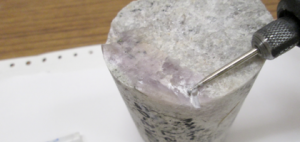REE Analysis of Anhydrite Veins in Porphyry Copper Deposits
April 26, 2013

Aaron Hantsche – Undergraduate, Jackson School of Geosciences
Porphyry copper deposits are created by hydrothermal mineralization as fluids from the intrusive body precipitate metal-rich minerals. These sulfur rich systems have anhydrite in the veined mineral assemblage, as well as quartz, pyrite, and chalcopyrite. Using dissolved anhydrite from veins from the Ertsberg Mining District, Papua, Indonesia, we have conducted a solution ICP-MS study to obtain rare earth element (REE) concentrations. The concentrations, normalized to chondrite, have been compared with REE patterns from the intrusive bodies in the district.
My study is focused on the REE evolution of the fluid and how that can be used to determine relative distance between a vein and a source body. Anhydrite patterns with higher La/Yb appear to be further removed from the source. Anhydrite REE patterns also show distinct positive and negative europium anomalies. This occurs because at high temperatures in aqueous solutions, europium occurs in a divalent state; at low temperatures, europium is more stable in a trivalent state. Anhydrite takes available divalent europium into its structure creating positive anomaly. At lower temperatures, further from the source, europium concentrations have been depleted resulting in a negative anomaly.
This means that REE patterns in anhydrite can be used as exploration tools for tracking intrusions in porphyry mining districts. Anhydrite sampling could provide an easy method to indicate preferential direction for exploratory drilling for ore prospects.